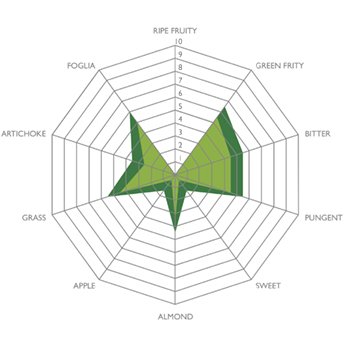One of the most characteristic features of the Italian olive growing community is its rich and varied heritage, naturally diversified from north to south.
However, looking at the market, only a small quantity which is marketed comes from the native varieties (cultivars) present in various ranges (mostly DOP/IGP and mono varietal oils).
However, the largest amount of oil marketed on a large scale with the wording 100% Italian is instead the result of a clever combination of national extra virgin oils obtained from different cultivars and ecosystems. This technique, called blending, aims to make a product with a standardized organoleptic profile “calibrated” on a wide audience of consumers.
The most precious ingredient in a blending is certainly the Coratina cultivar oil, carefully refined by adopting the correct cultivation and transformation techniques!
The cultivation of the Coratina variety is concentrated in the north of the Bari province (in Puglia) and occupies an area of more than 100,000 ha.
Characteristics of Coratina olive oil
One of the specific characteristics of this cultivar is the presence of a very high content of bioactive phenolic substances that give the oil, extracted from the olives at exactly the right level of ripeness, the positive sensory notes of medium intense bitterness and persistent spices: a structured oil that, in the jargon of professional tasters, is capable of acting as a “shoulder” to other more balanced oils.
This high concentration, although influenced by numerous agronomic and technological parameters, combined with a high percentage of oleic acid also has an important antioxidant effect on the product which guarantees it a long shelf life.
The health-giving properties of this oil must also not be overlooked: the direct correlation between the intake of polyphenols in olive oil and the protection of LDL cholesterol (Low Density Lipoprotein) from oxidative damage has been scientifically proven.
On the basis of this evidence, the European Commission has authorized the use of a health claim referring to this property, provided that the content of bioactive phenolic compounds is at least equal to 5 mg per 20 g of olive oil; this level is amply exceeded in the case of the Coratina cultivar which has an average value of 20.54 mg per 20 g.
Recently, mono-varietal oil from Coratina has been gaining more and more admirers. If in the past “sweet” oil was the preferred choice of the consumer, especially those in northern Italy and non-producing countries, today people are increasingly looking for a stronger character in the oil they choose.
In addition to the notes of medium intense bitterness and persistent spices mentioned previously, the mono varietal oil from Coratina is characterized by an intense fruity scent of green olives, sensations of fresh almond and marked vegetal and herbaceous notes.
Being a fragrant and structured oil, albeit balanced and harmonious, it should be combined, in appropriate quantities, with dishes where it can act as an important counterbalance: it is excellent with raw vegetables, hot vegetables, red meats and fatty fish.

